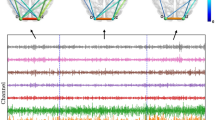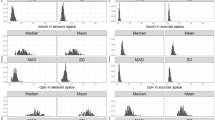Abstract
A large number of traffic accidents due to driver drowsiness have been under more attention of many countries. The organization of the functional brain network is associated with drowsiness, but little is known about the brain network topology that is modulated by drowsiness. To clarify this problem, in this study, we introduce a novel approach to detect driver drowsiness. Electroencephalogram (EEG) signals have been measured during a simulated driving task, in which participants are recruited to undergo both alert and drowsy states. The filtered EEG signals are then decomposed into multiple frequency bands by wavelet packet transform. Functional connectivity between all pairs of channels for multiple frequency bands is assessed using the phase lag index (PLI). Based on this, PLI-weighted networks are subsequently calculated, from which minimum spanning trees are constructed—a graph method that corrects for comparison bias. Statistical analyses are performed on graph-derived metrics as well as on the PLI connectivity values. The major finding is that significant differences in the delta frequency band for three graph metrics and in the theta frequency band for five graph metrics suggesting network integration and communication between network nodes are increased from alertness to drowsiness. Together, our findings also suggest a more line-like configuration in alert states and a more star-like topology in drowsy states. Collectively, our findings point to a more proficient configuration in drowsy state for lower frequency bands. Graph metrics relate to the intrinsic organization of functional brain networks, and these graph metrics may provide additional insights on driver drowsiness detection for reducing and preventing traffic accidents and further understanding the neural mechanisms of driver drowsiness.






Similar content being viewed by others
References
Breckel TPK, Thiel CM, Bullmore ET, Zalesky A, Patel AX, Giessing C (2013) Long-term effects of attentional performance on functional brain network topology. PLoS ONE. https://doi.org/10.1371/journal.pone.0074125
Buzsaki G, Draguhn A (2004) Neuronal oscillations in cortical networks. Science 304:1926–1929. https://doi.org/10.1126/science.1099745
Chen L-l, Zhao Y, Zhang J, Zou J-z (2015) Automatic detection of alertness/drowsiness from physiological signals using wavelet-based nonlinear features and machine learning. Expert Systems with Applications 42:7344–7355. https://doi.org/10.1016/j.eswa.2015.05.028
Craig A, Tran Y, Wijesuriya N, Boord P (2006) A controlled investigation into the psychological determinants of fatigue. Biol Psychol 72:78–87. https://doi.org/10.1016/j.biopsycho.2005.07.005
Evans JL, Selinger C, Pollak SD (2011) P300 as a measure of processing capacity in auditory and visual domains in specific language impairment. Brain Res 1389:93–102. https://doi.org/10.1016/j.brainres.2011.02.010
Filtness AJ, Armstrong KA, Watson A, Smith SS (2017) Sleep-related crash characteristics: implications for applying a fatigue definition to crash reports. Accid Anal Prev 99:440–444. https://doi.org/10.1016/j.aap.2015.11.024
Fu R, Wang H (2014) Detection of driving fatigue by using noncontect EMG and ECG signals measurement system. Int J Neural Syst. https://doi.org/10.1142/s0129065714500063
Fu R, Wang H, Zhao W (2016) Dynamic driver fatigue detection using hidden Markov model in real driving condition. Expert Syst Appl 63:397–411. https://doi.org/10.1016/j.eswa.2016.06.042
Gonzalez GF et al (2016) Graph analysis of EEG resting state functional networks in dyslexic readers. Clin Neurophysiol 127:3165–3175. https://doi.org/10.1016/j.clinph.2016.06.023
He J, Choi W, Yang Y, Lu J, Wu X, Peng K (2017) Detection of driver drowsiness using wearable devices: a feasibility study of the proximity sensor. Appl Ergon 65:473–480. https://doi.org/10.1016/j.apergo.2017.02.016
Jap BT, Lal S, Fischer P, Bekiaris E (2009) Using EEG spectral components to assess algorithms for detecting fatigue. Expert Syst Appl 36:2352–2359. https://doi.org/10.1016/j.eswa.2007.12.043
Kar S, Routray A (2013) Effect of sleep deprivation on functional connectivity of EEG channels. IEEE Trans Syst Man Cybern Syst 43:666–672. https://doi.org/10.1109/tsmca.2012.2207103
Kar S, Bhagat M, Routray A (2010) EEG signal analysis for the assessment and quantification of driver’s fatigue. Transp Res Part F Traffic Psychol Behav 13:297–306. https://doi.org/10.1016/j.trf.2010.06.006
Khasnobish A, Datta S, Bose R, Tibarewala DN, Konar A (2017) Analyzing text recognition from tactually evoked EEG. Cogn Neurodyn 11:501–513. https://doi.org/10.1007/s11571-017-9452-2
Khushaba RN, Kodagoda S, Lal S, Dissanayake G (2011) Driver drowsiness classification using fuzzy wavelet-packet-based feature-extraction algorithm. IEEE Trans Biomed Eng 58:121–131. https://doi.org/10.1109/tbme.2010.2077291
Kiroj VN, Aslanjan EV (2005) The general laws of formation of a condition monotony. Zhurnal Vysshei Nervnoi Deyatelnosti Imeni I P Pavlova 55:768–776
Klimesch W (1996) Memory processes, brain oscillations and EEG synchronization. Int J Psychophysiol 24:61–100. https://doi.org/10.1016/s0167-8760(96)00057-8
Klimesch W (1999) EEG alpha and theta oscillations reflect cognitive and memory performance: a review and analysis. Brain Res Rev 29:169–195. https://doi.org/10.1016/s0165-0173(98)00056-3
Kong W, Zhou Z, Jiang B, Babiloni F, Borghini G (2017) Assessment of driving fatigue based on intra/inter-region phase synchronization. Neurocomputing 219:474–482. https://doi.org/10.1016/j.neucom.2016.09.057
Lal SKL, Craig A (2002) Driver fatigue: electroencephalography and psychological assessment. Psychophysiology 39:313–321. https://doi.org/10.1017/s0048577201393095
Lal SKL, Craig A, Boord P, Kirkup L, Nguyen H (2003) Development of an algorithm for an EEG-based driver fatigue countermeasure. J Saf Res 34:321–328. https://doi.org/10.1016/s0022-4375(03)00027-6
Porz S, Kiel M, Lehnertz K (2014) Can spurious indications for phase synchronization due to superimposed signals be avoided? Chaos. https://doi.org/10.1063/1.4890568
Rau PS (2005) Drowsy driver detection and warning system for commercial vehicle drivers: field proportional test design, analysis, and progress. In: Proceedings of 19th international conference on enhanced safety of vehicles
Smith S, Carrington M, Trinder J (2005) Subjective and predicted sleepiness while driving in young adults. Accid Anal Prev 37:1066–1073. https://doi.org/10.1016/j.aap.2005.06.008
Stam CJ (2014) Modern network science of neurological disorders. Nat Rev Neurosci 15:683–695. https://doi.org/10.1038/nrn3801
Stam CJ, Nolte G, Daffertshofer A (2007) Phase lag index: assessment of functional connectivity from multi channel EEG and MEG with diminished bias from common sources. Hum Brain Mapp 28:1178–1193. https://doi.org/10.1002/hbm.20346
Stam CJ, Tewarie P, Van Dellen E, van Straaten ECW, Hillebrand A, Van Mieghem P (2014) The trees and the forest: characterization of complex brain networks with minimum spanning trees. Int J Psychophysiol 92:129–138. https://doi.org/10.1016/j.ijpsycho.2014.04.001
Tefft BC (2012) Prevalence of motor vehicle crashes involving drowsy drivers, United States, 1999–2008. Accid Anal Prev 45:180–186. https://doi.org/10.1016/j.aap.2011.05.028
Tewarie P, van Dellen E, Hillebrand A, Stam CJ (2015) The minimum spanning tree: an unbiased method for brain network analysis. Neuroimage 104:177–188. https://doi.org/10.1016/j.neuroimage.2014.10.015
van Dellen E et al (2015) Loss of EEG network efficiency is related to cognitive impairment in dementia with lewy bodies. Mov Disord 30:1785–1793. https://doi.org/10.1002/mds.26309
van Wijk BCM, Stam CJ, Daffertshofer A (2010) Comparing brain networks of different size and connectivity density using graph theory. PLoS ONE. https://doi.org/10.1371/journal.pone.0013701
Vanlaar W, Simpson H, Mayhew D, Robertson R (2008) Fatigued and drowsy driving: a survey of attitudes, opinions and behaviors. J Saf Res 39:303–309. https://doi.org/10.1016/j.jsr.2007.12.007
von Stein A, Sarnthein J (2000) Different frequencies for different scales of cortical integration: from local gamma to long range alpha/theta synchronization. Int J Psychophysiol 38:301–313. https://doi.org/10.1016/s0167-8760(00)00172-0
Wang Y-K, Chen S-A, Lin C-T (2014) An EEG-based brain-computer interface for dual task driving detection. Neurocomputing 129:85–93. https://doi.org/10.1016/j.neucom.2012.10.041
Wang H, Chang W, Zhang C (2016) Functional brain network and multichannel analysis for the P300-based brain computer interface system of lying detection. Expert Syst Appl 53:117–128. https://doi.org/10.1016/j.eswa.2016.01.024
Wu J, Zhang J, Ding X, Li R, Zhou C (2013) The effects of music on brain functional networks: a network analysis. Neuroscience 250:49–59. https://doi.org/10.1016/j.neuroscience.2013.06.021
Xu L, Wang B, Xu G, Wang W, Liu Z, Li Z (2017) Functional connectivity analysis using fNIRS in healthy subjects during prolonged simulated driving. Neurosci Lett 640:21–28. https://doi.org/10.1016/j.neulet.2017.01.018
Yu M, Gouw AA, Hillebrand A, Tijms BM, Stam CJ, van Straaten EC, Pijnenburg YA (2016) Different functional connectivity and network topology in behavioral variant of frontotemporal dementia and Alzheimer’s disease: an EEG study. Neurobiol Aging 42:150–162. https://doi.org/10.1016/j.neurobiolaging.2016.03.018
Zhang JH, Yin Z, Wang RB (2017) Nonlinear dynamic classification of momentary mental workload using physiological features and NARX-model-based least-squares support vector machines. IEEE Trans Hum Mach Syst 47:536–549. https://doi.org/10.1109/thms.2017.2700631
Zhao C, Zhao M, Yang Y, Gao J, Rao N, Lin P (2017) The reorganization of human brain networks modulated by driving mental fatigue. IEEE J Biomed Health Inform 21:743–755. https://doi.org/10.1109/jbhi.2016.2544061
Acknowledgements
We gratefully acknowledge the financial support from National Key R & D Program of China (2017YFB1300300), the Research Funds of State Key Laboratory of Automotive Simulation and Control, China (20171101) and the University Innovation Team of Liaoning Province (LT2014006).
Author information
Authors and Affiliations
Corresponding author
Rights and permissions
About this article
Cite this article
Chen, J., Wang, H., Hua, C. et al. Graph analysis of functional brain network topology using minimum spanning tree in driver drowsiness. Cogn Neurodyn 12, 569–581 (2018). https://doi.org/10.1007/s11571-018-9495-z
Received:
Revised:
Accepted:
Published:
Issue Date:
DOI: https://doi.org/10.1007/s11571-018-9495-z




